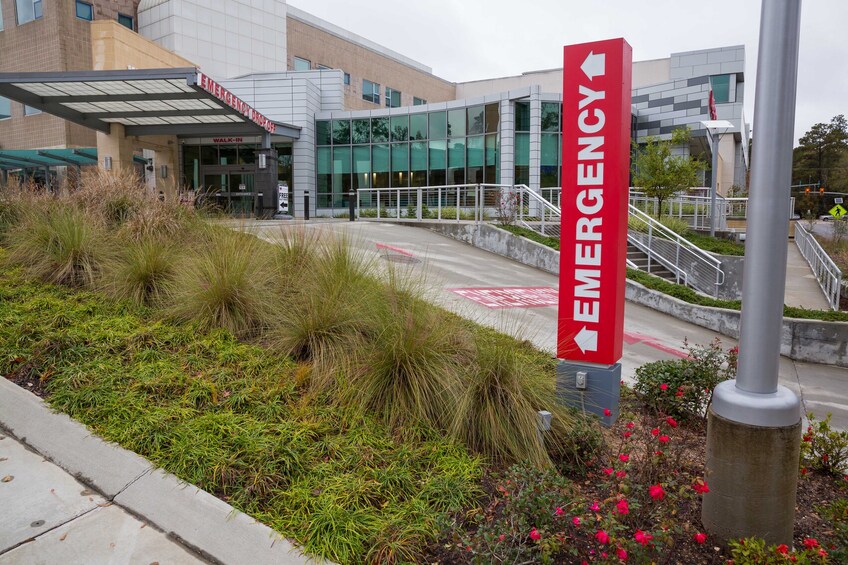How COVID-19 has changed life in the ER at St. Tammany Health System

A view of St. Tammany Health System’s Covington Emergency Department. (STHS file image)
By STHS Communication Department
As the COVID-19 coronavirus pandemic tightens its grip on the nation, most Americans are dutifully hunkering down, social distancing and binge-watching as they wait for the dust to settle.
Not Bradley Leonhard.
He’s the head of emergency services at St. Tammany Health System, and – like much of the staff at the Covington hospital – he was planning for COVID-19 long before Louisiana even logged its first COVID-positive patient on March 9.
But although the ensuing weeks have brought a multitude of changes in processes and practices for healthcare providers across the country, Leonhard – who, as an Emergency Department veteran, is no stranger to pressure -- has been rolling with the punches.
On Monday (March 30), he was a guest on The Lake 94.7 FM to talk about the coronavirus response at STHS and to offer advice for the public as they grapple with the outbreak and all it entails. Below, find an edited transcript of Leonard’s Monday segment. You can also listen to the full segment online at Lake947.net.
Describe how STHS is managing this as we go through this pandemic.
We totally changed our whole flow and process through the ER, so every patient is screened at the front entrance of the Emergency Department for signs and symptoms related to the COVID virus. If the patient is in respiratory distress, they are immediately brought back to a room. If the patient is stable and has signs and symptoms, we have erected a tent and we are treating patients from that tent to limit exposure to our staff. Every patient that’s coming through our doors is receiving a mask to protect themselves as well as our nursing staff.
Is this uniform around the country? Is this how other emergency rooms are handling this?
Emergency medicine, we’re a big group. We work with each other and we have conference calls …, bouncing ideas off of each other, and we all seem to be doing the same thing right now: trying to screen these patients early, preventing them from coming to the ER unless it’s a true emergency, using outpatient testing, using tele-visits. We’re all aligning together and supporting each other as a healthcare profession right now.
Who is coming to the emergency room? I’ve heard this from several different people, this idea of ‘Call ahead if it’s not a true emergency and let’s make sure this is the best place or time for you to be there.’
I would agree with that. Here at St. Tammany Health System, we have set up multiple lines of defense for the ER so we don’t get inundated and (so we can) keep the people who don’t belong in the ER out. Obviously, if you think you have a medical emergency, we’re ready for you. We’re going to handle you. We’re going to provide you the best care possible. But if you don’t feel that you’re in respiratory distress or (that it’s) a true emergency, reach out to your primary care doctor. Reach out to urgent care. A lot of these places are doing video visits now, allowing you to stay home, (to be) seen and screened by a medical provider before coming into any medical facility. And they can direct you to outpatient testing or to the ER if necessary.
So, yes, you may have it, but it may be best just to stay where you are for the time being.
Protecting yourself and your family is just as important as protecting medical staff. A low-grade fever doesn’t necessarily meet admission criteria, or even criteria to come to the ER. If you can get screened by your primary care physician and get outpatient testing, self-isolation for 14 days might be what’s best for yourself, your family and the community.
As far as the next week, two weeks, three weeks, I guess nobody really knows where the turnaround is on this, do we?
It’s hard to say. You hear the term “flatten the curve” and what everybody can do to flatten the curve – you hear the governor, you hear the president extending the social isolation orders. We need to take that very seriously. It does make an impact. Hopefully we’ll see maybe we are starting to flatten the curve. But if people stay home -- don’t go unnecessarily shopping, don’t go to crawfish boils, don’t go to family’s houses, just isolate ourselves at home with immediate family -- that’s what we can do to prevent the spread of this disease and hopefully we can flatten this curve.
For the latest updates on COVID-19 in St. Tammany Parish, visit STPH.org/COVID-19.